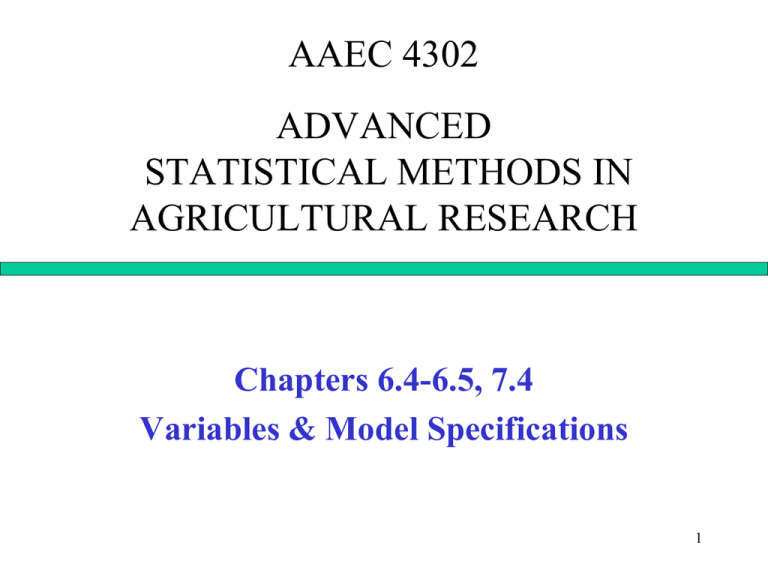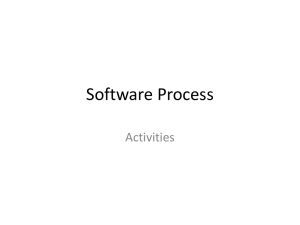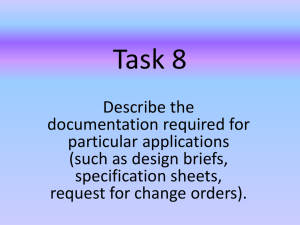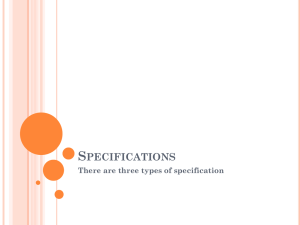aeco4302 statistical methods in agricultural research
advertisement

AAEC 4302
ADVANCED
STATISTICAL METHODS IN
AGRICULTURAL RESEARCH
Chapters 6.4-6.5, 7.4
Variables & Model Specifications
1
The Reciprocal Specification (6.4)
• The reciprocal model specification is:
1
ˆ
ˆ
ˆ
Yi B0 B1
Xi
Reciprocal Model Specification
7.00
6.00
5.00
Y
4.00
3.00
2.00
1.00
0.00
1
2
3
4
5
6
7
8
9
10
X
2
The Reciprocal Specification
1 ˆ
ˆ
ˆ
ˆ
Yi B0 B1 B2 X 2i ... Bˆ k X ki i 1,...,n
X 1i
• Relationship between Y and the transformed
independent variable XT 1 is linear
ji
X ji
ˆ B
ˆ XT B
ˆ X ... B
ˆ X e
Yi B
0
1
1i
2
2i
k
ki
i
3
The Reciprocal Specification
• Therefore, the standard OLS method (i.e.
formulas) can be used to fit this line
1
• Instead of X ji , XTji
i 1,...,n is used as the
X ji
jth independent variable in the OLS formulas or
in the data set given to the Excel program for
calculating the OLS parameter estimates
Geometry of the reciprocal relation is shown on
page 116
4
The Reciprocal Specification
• Model specified relation between inflation and
unemployment as reciprocal, observations for 15
observations (1956-1970):
1
ei
Yi B0 B1
X 1i
• UINVi = 1/UMPLi
• INFLi = B0 + B1*UINVi + ui
• The estimated regression is:
INFLi = -1.984 + 22.234*UINVi +ei
R2= 0.549 SER=0.956
5
The Reciprocal Specification
• B0 =-1.984
• As UNEML increases, INFL decreases and
approaches the lower limit of -1.984 percent
• Quantitative implications are understood when we
compare diff. predicted values of INFL for diff.
rates of unemployment
• If UNEMPL = 3%, INFL = -1.984 +22.234*(1/3)
= 5.43 %
• If UNEMPL = 4%, INFL = -1.984 +22.234*(1/4)
= 3.57 %
6
The Log-Linear Specification (6.5)
• A special type of non-linear relations become linear when
they are transformed with logarithms
• Specifically, consider
Yi e X1 X 2 ...X k
B0
B1
B2
Bk
• We take natural logs of both sides of this equation:
ln Yi B0 B1 ln X1i B2 ln(X 2i ) ... Bk ln(X ki ) ui
• This is also known as the Log-Log or Double-Log
specification, because it becomes a linear relation when
taking the natural logarithm of both sides
7
The Log-Linear Specification
• The former implies that the usual OLS formulas
(or the standard Excel program) can be used to
estimate the coefficients of a Log-Linear model
specification, but they are applied to lnYi and
( X 1i , ln X 2i ,...,ln X ki , instead of Yi and X 1i ,
ln
(X 2i ,..., X ki (i.e. let Yi lnYi and
(X 1i ln X 1i , X 2i ln X 2i ,..., X ki ln X ki
for all i’s and then use the OLS formulas or the
Excel program)
8
The Log-Linear Specification
• A disadvantage of the log-linear specification
is that one has to assume that all of the Y-Xj
relations in the model conform to this type of
non-linear specification (i.e. one needs to take
the ln of Y and of all of the independent
variables in the model)
• In short, in the Log-Linear model specification:
Figure 6.3 page 120
9
The Log-Linear Specification
• An important feature is that Bˆ j directly
measures the elasticity of Y with respect to Xj;
i.e. the percentage change in Y when Xj
changes by one percent
• Notice in this model specification the slope (i.e.
the unit change in Y when Xj changes by one
unit) is not constant (it varies for different
values of Xj), but the elasticity is constant
throughout!
10
The Log-Linear Specification
• B1 =1.2
• 5% change in X will cause Y change by:
1.2 * 0.05 = 0.06, or 6%
11
The Log-Linear Specification
• Model of aggregate demand for money in
the US
• We construct variable - real quantity of
money: Mi= NMi / (PrIndGNPi /100)
• Ln Mi= Bo + B1 ln GNPi + Ui
• Estimated regression:
LnMi= 3.948 + 0.215 LnGNPi
R2 = 0.78 SER=0.0305
12
The Log-Linear Specification
• B1= 0.215, or 0< B1<1 the elasticity of M
with respect to GNP is 0.215
• 5% increase in GNP leads to
0.215*5=1.075% increase in predicted M
• Predict demand for money when GNP =
1000: ln1000=6.908
lnM = 3.948 + 0.215*6.908 = 5.433
Antilog of 5.433 = 222.8 bill $
13
The Polynomial Specification (7.4)
• A polynomial model specification (with
respect to X 1 only) is:
2
ˆ
ˆ
ˆ
ˆ
ˆ X ... Bˆ X
Yi B0 B11 X1i B12 X1i B
2 2i
k ki
Polynomial Specification
60
50
Y
40
30
20
10
0
1
2
3
4
5
6
X1
7
8
9
10
11
14
The Polynomial Specification
• In a polynomial specification, as Xj increases,
Y can increase or decrease at an increasing or
at a decreasing rate: it is a very flexible nonlinear model specification
• An advantage of the polynomial model
specification is that it can combine situations in
which some of the independent variables are
non-linearly related to Y while others are
linearly related to Y
15
The Polynomial Specification
• A polynomial model can be estimated by OLS,
2
viewing X j as any other independent variable
in the multiple regression
16
The Polynomial Specification
Multiple regression :
EARNSi B0 B11Ed1i B12 EXP1i B13 EXPSQ
Cross-sectional DB with 100 observations
Estimated EANRS function:
EANRSi = -9.791 +0.995 EDi + 0.471EXPi –
0.00751EXPSQi
R2=0.329 SER4.267
B 1= 0.995 – holding the level of experience constant one additional
year of education increases earnings by $995
EANRSi = constant + 0.471EXPi – 0.00751EXPSQi
where the “constant” depends of the particular value
chosen for ED
17
The Polynomial Specification
• Slope = 0.471 + (2)(-0.00751)EXP
• If EXP = 5 years, then
slope = 0.471 + (2)(-0.00751)(5) = 0.396thou $
• To find the level of experience corresponding with the pick of
earnings
0 = 0.471 + (2)(-0.00751)EXP , EXP = 31.4
• To assess the effect on earnings by change in experience
∆EARNS = {0.471+2(-0.00751)EXP}∆EXP
Worker with EXP=10, add 2 add. years of experience
∆EARNS = {0.471+2(-0.00751)10}2 = 0.6416 thousand $
• To assess the effect on earnings by change in experience
∆EARNS = 0.471∆EXP -0.00751∆EXPSQ
∆EARNS = (0.471)* (2 ) - 0.00751* 44 = 0.6116 thousand $
18
2
2
12 – 10 = 44









